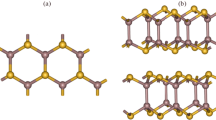Abstract
The process of rolling a monolayer of bulk crystal with biperiodical planar lattice to the nanotube was analyzed. It was shown by an example of the carbon nanotubes how the tube symmetry can be revealed through the analysis of symmetry of graphene layers (the layer group with a hexagonal planar lattice) and its changes at the rolling to form the tube. The developed approach can be used to analyze the symmetry of any nanotube. A computer program we developed is discussed that allows to determine the nanotube symmetry using the data on the symmetry and coordinates of the atoms in the nanolayer and get the coordinates of the atoms in the unit cell of the nanotube which can be used for the further quantum-chemical calculations. The method and results of ab initio calculations of the titanium dioxide monolayer stability in the LCAO basis optimized for the bulk crystal, using the hybrid exchange-correlation potential PBE0 are presented. Symmetry properties of nanotubes obtained by rolling the three- and six-plane monolayers (101) and (001) of anatase are discussed. Atomic and electronic structure of TiO2 nanotubes found by geometry optimization is analyzed. It is shown that titanium dioxide nanotubes based on the three-plane monolayers with hexagonal and square lattice are approximately of the same stability. The data on the stability of nanotubes are essential for the synthesis of new nanomaterials based on titanium dioxide.
Similar content being viewed by others
References
Zakharova, G.S., Volkov, V.L., Ivanovskaya, V.V., and Ivanovskii, A.L., Nanotrubki i rodstvennye nanostruktury oksidov metallov (Nanotubes and Related Nanostructures of Metal Oxides), Yekaterinburg: Inst. Solid State Chem., 2005.
D’yachkov, P.N., Uglerodnye nanotrubki. Stroenie, svoistva, primeneniya (Carbon Nanotubes: Structure, Properties, and Application), Moscow: Binom, 2006.
International Tables for Crystallography, Subperiodic Groups, Kopsky, V. and Litvin, D.B., Eds., Kluwer Academic Publishers, 2002, vol. E.
Damnjanović, M., Nicolić, B., and Milošević, B., Phys. Rev., B, 2007, vol. 75, p. 033403.
Damnjanović, M. and Milošević, I., Line Groups in Physics: Theory and Applications to Nanotubes and Polymers. Lecture Notes in Physics, Berlin, Heidelberg: Springer Verlag, 2010, vol. 801, p. 180.
Damnjanović, M., Milošević, I., Vucović, T., and Sredanović, R., Phys. Rev., B, 1999, vol. 60, p. 2728.
Python programming language. Python Software Foundation, 2009, http://www.python.org .
Bahn, S.R. and Jacobsen, K.W., Comput. Sci. Eng., 2002, vol. 4, p. 56.
Togo, A., Oba, F., and Tanaka, I., Phys. Rev., B, 2008, vol. 78, p. 134106-1–9.
Stokes, H.T., Hatch, D.M., and Campbell, B.J., ISOTROPY User’s Manual, Provo, UT, USA, 2007; http://stokes.byu.edu/isotropy.html
Dovesi, R., Saunders, V.R., Roetti, C., Orlando, R., Zicovich-Wilson, C.M., Pascale, F., Civalleri, B., Doll, K., Harrison, N.M., Bush, I.J., D’Arco Ph., and Llunell, M., CRYSTAL06(09) User Manual, Turin: Univ. of Turin, 2010, http://www.crystal.unito.it .
Bandura, A.V. and Evarestov, R.A., Surf. Sci., 2009, vol. 603, p. L117.
Damnjanović, M., Milošević, I., Vucović, T., Dobardzić, E., and NikolliĆ, B., Phys. Rev., B, 2004, vol. 69, p. 153401
Ernzerhof, M. and Scuseria, G.E., J. Chem. Phys., 1999, vol. 110, p. 5029.
D’yachkov, P.N., and Makaev, D.V., Phys. Rev., B, 2007, vol. 76, p. 195411.
Evarestov, R.A., Quantum Chemistry of Solids. The LCAO First Principles Treatment of Crystals. Springer Series in Solid State Sciences, Berlin: Springer Verlag, 2007, vol. 153, p. 558.
Hurley, M.M., Pacios, L.F., Christiansen, P.A., Ross, R.B., and Ermler, W.C., J. Chem. Phys., 1986, vol. 84, p. 6840.
Schäfer, A., Huber, C., and Ahlrichs, R., J. Chem. Phys., 1994, vol. 100, p. 5829.
Press, W.H., Teukolsky, S.A., Vetterling, W.T., and Flannery, B.P., Numerical Recipes in Fortran 77, 2nd ed., Cambidge Univ. Press, Cambridge, MA, 1997.
Evarestov, R.A., Panin, A.I., Bandura, A.V., and Losev, M.V., J. Phys. Conf. Ser., 2008, vol. 117, p. 012015.
Monkhorst, H.J. and Pack, J.D., Phys Rev., B, 1976, vol. 13, p. 5188
Peng, H., Phys. Lett., A, 2008, vol. 372, p. 1527.
Labat, F., Baranek, P., Domain, C., Minot, C., and Adamo, C., J. Chem. Phys., 2007, vol. 126, p. 154703.
Maiyalagan, T., Viswanathan, B., and Varadaraju, U.V., Bull. Mater. Sci., 2006, vol. 29, p. 705.
Labat, F., Baranek, P., and Adamo, C., J. Chem. Theory Comput., 2008, vol. 4, p. 341.
Enyashin, A.N. and Seifert, G., Phys. Stat. Sol., B, 2005, vol. 242, p. 1361.
Ma, R., Bando, Y. and Sasaki, T., Chem. Phys. Lett., 2003, vol. 380, p. 577.
Vittadini, A., Casarin, M., and Selloni, A., Theor. Chem. Acc., 2007, vol. 117, p. 663.
Lazzeri, M., Vittadini, A., and Selloni, A., Phys. Rev., B, 2001, vol. 63, p. 155409.
Vittadini, A. and Casarin, M., Theor. Chem. Acc., 2008, vol. 120, p. 551.
He, T., Zhao, M., Zhang, X., Zhang, H., Wang, Z., Xi, Z., Liu, X., Yan, S. Xia, Y., and Mei, L., J. Phys. Chem., C, 2009, vol. 113, p. 13610.
Szieberth, D., Ferrari, A.M., Noel, Y., and Ferrabone, M., Nanoscale, 2010, vol. 2, p. 81.
Wang, J., Wang, L., Ma, L., Zhao, J., Wang, B., and Wang, G., Physica, E, 2009, vol. 41, p. 838
Liu, Z., Zhang, Q., Qin, L.C., Solid State Comm., 2007, vol. 141, p. 168.
Lin, F., Zhou, G., Li, Z., Li, J., Wu, J., and Duan, W., Chem. Phys. Lett., 2009, vol. 475, p. 82
Evarestov, R.A., Bandura, A.V. Losev, M.V., Piskunov, S., and Zhukovskii, Yu.F., Physica, E, 2010 (in press).
Enyashin, A.N., Gemming, S., and Seifert, G., Simulation of Inorganic Nanotubes, Materials for Tomorrow. Theory, Experiments and Modelling, Springer Series in Materials Science, 2007, vol. 93, 2007, p. 33.
Ivanovskaya, V.V., Enyashin, A.N., and Ivanovskii, A.L., Mendeleev Commun., 2003, vol. 13, p. 5.
Author information
Authors and Affiliations
Corresponding author
Additional information
Original Russian Text © R.A. Evarestov, A.B. Bandura, M.V. Losev, 2010, published in Zhurnal Obshchei Khimii, 2010, Vol. 80, No. 6, pp. 982–998.
Rights and permissions
About this article
Cite this article
Evarestov, R.A., Bandura, A.B. & Losev, M.V. Symmetry and stability of nanotubes based on titanium dioxide. Russ J Gen Chem 80, 1152–1167 (2010). https://doi.org/10.1134/S1070363210060198
Received:
Published:
Issue Date:
DOI: https://doi.org/10.1134/S1070363210060198




